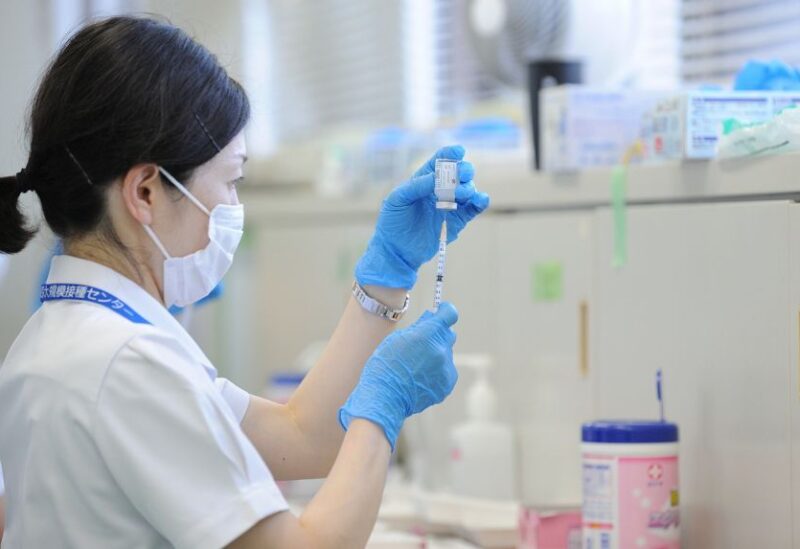
Nurses providing vaccines against the coronavirus disease
Tamio Hayashi, 77, believed he would ever be able to traverse the online platforms set up across most of Japan to register for COVID-19 immunizations.
He despised the thought of using the “difficult” technologies that had broken down and perplexed other elderly citizens, stymieing Japan’s vaccination campaign.
Fortunately, local officials in his little northeastern town guided him through the red tape and he received his vaccinations – a rare occurrence in Japan, where authorities are rushing to immunize the fragile senior population in time for the Summer Olympics, which begin in only six weeks.
“This way is great,” Hayashi told Reuters after he and his wife got their second doses at a local gymnasium. “You just get a notice that says come on such-and-such a day.”
Soma, a rural city 240 kilometers (150 miles) north of Tokyo that was devastated by the 2011 earthquake and tsunami, has surged ahead of most of the country in vaccinations by heeding lessons learned from the catastrophe of a decade ago.
Japan lags far behind other advanced economies in vaccinating its people – 12% have received at least one shot, according to a Reuters tracker, compared to France, the next lowest in the Group of Seven industrial powers at 42%, and the most advanced, Canada, at 63%.
Soma’s agile, in-house strategy avoids the reservation systems and dispersed efforts that are popular in Japan. The city has vaccinated 84 percent of its older residents, compared to approximately 28 percent nationally, and is now targeting younger generations, with the goal of reaching people as young as 16 by the end of July, just as the Olympics begin.
Prime Minister Yoshihide Suga wants all people in Japan to be fully vaccinated by July and the elderly by November. But that will necessitate increasing daily doses to a million from the current top of roughly 700,000.
Part of Soma’s success is due to its small population of 35,000, making it easier to reach people in the city on the Pacific coast in Fukushima prefecture than for stretched medical staff in the giant urban areas.
But the city is also succeeding where much of Japan has not because of the painful lessons of the tsunami that killed 450 of the city’s people as it swept 4 kilometers (2.5 miles) inland.
‘PEOPLE COMING TOGETHER’
That disaster taught Soma the importance of laying out and communicating clear plans, working closely with local medical professionals, gathering affected people in concentrated places – and not waiting for a plan to come down from Tokyo – said Vice Mayor Katsuhiro Abe.
“I’m not sure you could claim we couldn’t have done it if it hadn’t been for the earthquake,” Abe remarked. “However, this immunization campaign coincides with the municipal government’s experience and the people joining together to cope with it for the past ten years.”
Japan has escaped the massive COVID-19 case loads and death tolls observed in many other countries, although its vaccine deployment began later than others, in mid-February, and was initially hampered by a lack of imported vaccine supplies.
The elderly were prioritized for vaccinations, but distribution was inconsistent, and reservation mechanisms broke down or confused them.
Soma’s leaders and doctors, drawing on 2011 lessons, began drafting plans and running inoculation drills in December, months before vaccines were approved.
The city set up a central vaccination center, conserving medical manpower. Residents were called by city block, no reservation necessary, and the city sent busses for those who could not travel on their own.
After the previous disaster, Soma’s neighbors know to look out for each other, while city officials are used to shifting gears from office work to crisis management, said Abe, a lifelong Soma resident.
Townspeople are shuttled briskly to waiting areas and screenings, then to a partitioned area for their shots.
When some older patients got flustered being asked to turn left or right for their shots, staff improvised with cartoon posters on the walls: face the bunny for an injection in your right arm, turn to the doggy to get it in the left arm.
“The strategy needs to be tailored to each local culture and context,” said Kenji Shibuya, who this spring resigned as director of the Institute for Population Health at King’s College London to help run Soma’s COVID-19 vaccination push.
“It’s a war,” said Shibuya, a persistent critic of Japan’s handling of the pandemic.
He said the best thing the government can do is provide a steady supply of vaccines and supplies to municipalities – and leave the rest to the people on the ground.